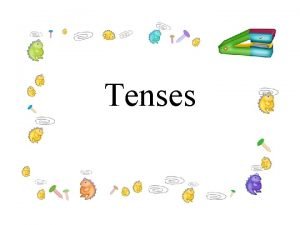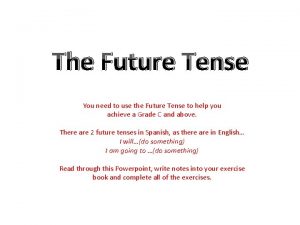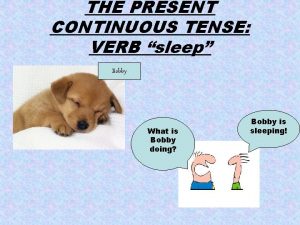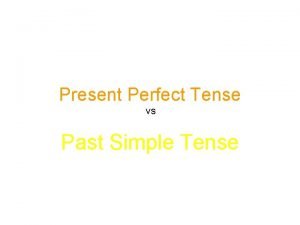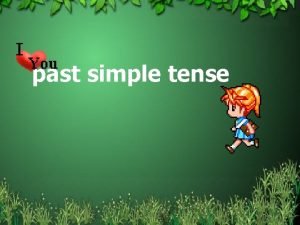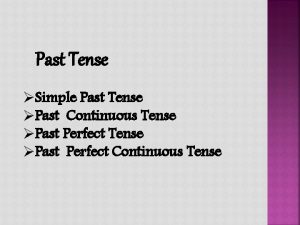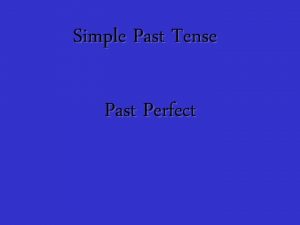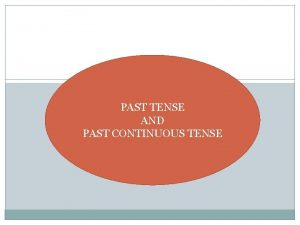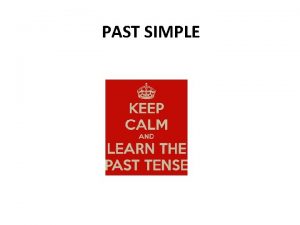The Simple Past Tense The simple past tense










- Slides: 10

The Simple Past Tense The simple past tense is used to talk about actions that happened at a specific time in the past. You state when it happened using a time adverb (yesterday, last week, tow days ago, etc. ) For example: 1 - I lived in South Africa for two years. 2 - She cleaned her room yesterday.

You form the simple past of a verb by adding -ed onto the end of a regular verb , but irregular verb forms have to be learned.

Spelling rules for regular verb 1) Double the consonant if the consonant is stressed stop – stopped swap – swapped 2)Add only –d, when the verb ends with –e love – loved save – saved 3)Verbs ending in 'y' preceded by a consonant: Change 'y' to 'i' Then add -ed. hurry - he hurried (play – played)

Negative Sentences did not + verb (base form) Example 1 : I did not work yesterday or I didn’t work yesterday INCORRECT: I didn’t worked

Regular Verb (to Questions work) Statements + - ? Short answer + No, I didn't. I worked. I didn't work. Did I work? [He/She/It] worked. [He/She/It] didn't work. Yes, Did [he /she [he/she/It] / It] work? did. No, [he/she/I t] didn't. [You/ We/They] didn't work. Did [you/ we/they] work? No, [you/ we/they] didn't. worked. Yes, I did. Yes, [you/ we/they] did.

Question In the past simple we use did as a helping verb to form a question with Wh - word. 1 – He cleaned his car. ² What did he clean? 2 – I cocked the dinner. ² When did you cock? 3 – She wrote a book.

Past Continuous Tense 1 – We use this tense to talk about actions that were going on, or happening at a certain moment in the past. v At this time last Saturday, Ahmad was playing in the park with his friends. 2 - We often use past continuous to say what was in progress, when something happened: v The phone rang while I was doing my homework. v I was reading a comic book while my sister was watching TV. v When I was walking along the road, I saw a car hit a motorbike.

Positive and Negative in Past Continuous Positive Negative Subject + was + v-ing Subject+ wasn’t(not) + v-ing 1) I was studying. 1) I wasn’t (not) studying. 2) He was playing. 2)He wasn’t (not) playing. Subject + were + v-ing Subject + weren’t(not) + v-ing 1) You were reading. 1) You weren’t (not) reading. 2) They were sleeping. 2) They weren’t (not) sleeping

Making Yes/No Questions in Past Continuous Ø Was + He, She, It + v-ing? He was working. Was he working? Yes, he/ she/ it + was. No, he/ she/ it + wasn’t. Ø Were + you, we, they + v-ing? They was working. Were they working? Yes, you/ we/ they+ were. No, You/ we/ they + weren’t.

Making Wh- word Question in Past Continuous In the past continuous we use was or were to form a question with Wh - word. 1 – He was playing tennis at 9 o'clock last night. ² When was he playing tennis? 2 – You were cocking the dinner all the after noon yesterday. ² What were you doing all the after noon yesterday? 3 – She was writing a book When I visited her.
 Have en futuro simple
Have en futuro simple The use of the past continuous
The use of the past continuous Past t continuous tense
Past t continuous tense Simple present verbs
Simple present verbs Past simple + past perfect
Past simple + past perfect Past simple and past continuous and past perfect
Past simple and past continuous and past perfect What is simple future tense?
What is simple future tense? Future perfect tense sleep
Future perfect tense sleep Present perfect vs past simple
Present perfect vs past simple Present simple de drive
Present simple de drive Past perfect and past continuous
Past perfect and past continuous



